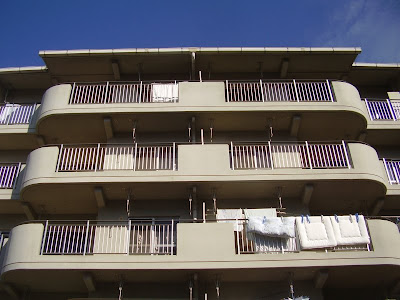
Himeji Castle stands on a hill, looking a little disappointing from afar as it blended into the bleak sky on the day of our visit. Sometimes known as the White Heron Castle it is a Japanese National Treasure and a UNESCO World Heritage site. Upon entering the castle, visitors are required to remove their shoes and shuffle up, and up, and up the flights of smooth wooden stairs in borrowed slippers or stockinged feet. In addition to potentially damaging the beautifully crafted wooden buildings, all 83 of them, that comprise the castle complex, people are a major threat for another reason...fire. Many of Japan's wooden structures have suffered devastating losses due to fire and the castle is full of signs constantly reminding visitors not to smoke.
As the most visited castle in Japan it was very interesting wandering through the grounds, a maze created in order to confuse attacking troops, entering through imposing gates and later ducking our heads to step through narrow, low doorways. Inside the castle were dark wooden walls, a strange contrast to the light, bright exterior. The most interesting architectural feature though must surely be the roofline, gently curving up at each end, giving it a graceful, somehow feminine touch. Thought to be originally built in the 1300's the history of the castle was a little contradictory. As we climbed up to the top floor, following a group of international students marvelling at the evidence of where weapons once hung in readiness for battle, or completely uninterested in the buildings stories I was reminded that whatever we chose to do today will be remembered and appreciated by some of those yet to come, and completely irrelevant to others.
I certainly don't imagine that the architects and labourers who constructed this castle completely from hand ever expected their handiwork to still be standing in the 21st century, with ipod clad teenagers and camera toting tourists clambering in and around it. I wonder what they would have made of us?

























 My friend Kaz works for Japan Airline (JAL) and as a family unit they are typically transferred every 3 years. At the time of planning our trip Kaz was expecting to be transferred at any time. Thankfully they were still based near Osaka when we touched down.
My friend Kaz works for Japan Airline (JAL) and as a family unit they are typically transferred every 3 years. At the time of planning our trip Kaz was expecting to be transferred at any time. Thankfully they were still based near Osaka when we touched down.














